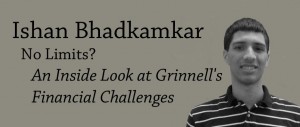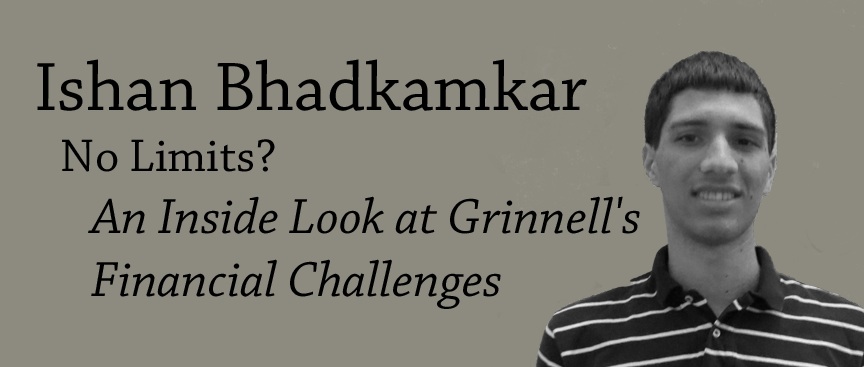
As the academic year and the “No Limits?” column draw to a close, I find myself reminiscing over the many topics covered by this column during the semester. In January, I set out to start a discussion in the Grinnell community about the financial challenges faced by the college. “No Limits?” has explored the endowment, need-blind financial aid, fundraising and alumni giving, net student revenues and rising higher education costs. While I will graduate in a few weeks and move on to the next stage of my life, Grinnell—and its financial challenges—will remain. The road ahead is filled with difficult decisions, but there are concrete objectives Grinnell can measure its progress towards.
The first order of business is increasing net student revenues (collected tuition minus financial aid). In order to preserve a need-blind admission policy and meet 100 percent of demonstrated financial need, Grinnell must attract more students that pay “sticker price.” This can be accomplished without diminishing the academic profile of incoming classes. The majority of our peer liberal arts colleges have higher percentages of full-paying students, which allows them to offer generous financial aid packages without draining other financial resources. In the near future, net student revenues should grow from its current 36 percent of the annual budget to over 40 percent (Amherst is at 43 percent). Grinnell must also reduce its discount rate (financial aid provided to students divided by collected tuition and fees) from a whopping 61 percent to the low 50s. This will alleviate annual budgetary pressure and allow Grinnell to offer comprehensive financial aid to those who need it.
Second, Grinnell must not deplete its endowment. The $1.45 billion endowment is the college’s most valuable resource and sets Grinnell apart financially from many peer institutions. The endowment must support Grinnell in perpetuity, but it will be increasingly unable to do so if it continues to fund 53 percent of the annual budget. This is problematic for two reasons: (1) It exposes the college to market vulnerabilities and, if the endowment value falls, the annual budget will disproportionately suffer; (2) It pushes the endowment toward short term, more liquid investments, which restricts its long-term growth potential. Further, our endowment receives far less in gifts than most other liberal arts colleges, constraining its growth even more. Grinnell must look to increase endowment gifts and reduce the percentage of the annual budget that is endowment-funded to around 45 percent.
Third, fundraising must improve substantially for Grinnell to remain competitive. Peer institutions dramatically out-raise Grinnell across the board, with higher rates of both total fundraising and alumni participation. The College has made significant changes to its alumni and development offices that will improve results, but Grinnell remains years away from closing its $22.2 million annual fundraising gap with Carleton. Short-term goals should be to raise $10 million annually and increase the alumni participation rate to 50 percent. Over the long-term, Grinnell must create an impetus for giving and lay the foundation for a large-scale fundraising campaign for capital improvements and program expansion.
Finally, Grinnell must manage itself prudently. It must continue to raise the college’s academic profile by recruiting talented faculty and staff and admitting high-achieving students. Efficient cost cutting is essential: higher education costs cannot rise forever and Grinnell must carefully allocate resources to core items. Most importantly, Grinnell must not shy away from challenges. Many changes will buffet higher education soon, including the Supreme Court’s ruling on affirmative action, declining government support for Pell Grants, shifting racial and geographic population demographics and the emergence of online education. Grinnell cannot blindly defend the liberal arts model: it must lead, embrace change and adapt in order to thrive.
These issues will involve many serious tradeoffs. Sacred cows will have to be sacrificed and there will undoubtedly be resistance to change from various parts of the Grinnell community. But the fact that choices are difficult does not mean that choices do not need to be made. Strong leadership, fiscal prudence, widespread engagement and pragmatic vision will maintain and improve Grinnell’s status as a world-class institution and premier liberal arts college. We can succeed, and I hope we do.
Ishan Bhadkamkar ’13 is an intern with the Grinnell College Investment Office.



















































Joanna • May 8, 2013 at 4:26 pm
A free lunch for you won’t be on my donation.
As long as the college can afford to provide free sandwiches for lunch at the Convo (so there still must be cookies at all the 4:15s in South Lounge?), then I’ll never believe it is more important to give my money to Grinnell than just about any other deserving charity anywhere else.
Really? Come on, for a place so self-proud about social justice, the actions on campus are a lens into a hypocrisy of privilege, classism, and arrogance — “do as we say, not as we do”.
Your columns have been interesting, but you seem to wrapped up in the admins numbers.
P.S. — I was in school with Penny Sebring and have always admired her work. She’s worth your time sandwich or not.
Jim • May 8, 2013 at 4:15 pm
The funny thing about asking for donations is that you gotta have a meritorious need. The premise of this year’s review of the need-blind aid is that such a meritorious action requires a substantial investment. And thus we are to realize the implied conclusion and dig deeply to support such a noble cause.
Many (but to be fair not all) from my era have the view that the Grinnell of today has over-indulged in interesting sidelights that detract from its outstanding academics. I point to the prison teaching, others scoff at your prize. Inspiring as these might be, their loss would not undermine the core functionality of the EDUCATIONAL mission of Grinnell. Yet these are the things we hear about.
Tell me about Rhoads Scholars or Watsons, about faculty publication and teaching innovation, and other things that relate to the academic strength and it is easier to think about donating to provide access to that.